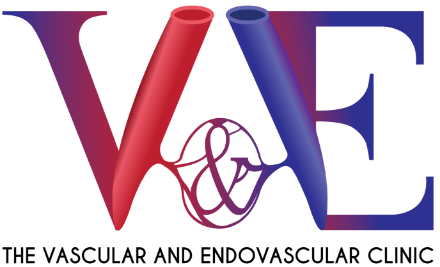Varicose veins are a common condition affecting both men and women, particularly in Singapore’s ageing population.
Characterised by swollen, twisted veins, varicose veins are not just a cosmetic concern but can also lead to discomfort and more severe health complications.
The good news? There are a variety of effective varicose vein treatment options in Singapore, including minimally invasive treatments with little to no downtime.
This guide will walk you through everything you need to know about varicose veins, from symptoms and risk factors to treatment options and costs.
What Are Varicose Veins?
Varicose veins are enlarged, swollen veins that appear twisted and dark blue or purple. They usually develop in the legs, but can also occur in the feet and ankles.
Unlike regular veins that function efficiently and maintain a normal appearance, varicose veins:
- Have weakened or damaged valves, causing blood to pool and creating increased pressure inside the veins.
- Often have a rope-like, bulging appearance.
- Comes with symptoms such as heaviness, aching, swelling, and itching.
Varicose veins increase your risk of Deep Vein Thrombosis (DVT), a condition that causes blood clots to form in deep veins. If left untreated, this clot can travel to the lungs, causing a Pulmonary Embolism (PE).
Symptoms of Varicose Veins
Common symptoms of varicose veins include:
- Swollen, bulging veins
- Heavy or aching legs, particularly after prolonged standing
- Restless legs
- Wounds that take a long time to heal (chronic wounds)
- Skin discoloration around the affected area
- Itching or irritation around the veins
- Muscle cramps in the legs, especially at night
It is important to note that these symptoms typically develop gradually rather than appearing all at once. They tend to progress in severity as the condition advances through its stages*:
Stages 1&2
Visible bulging bluish-green veins just under the skin.
Stage 3
Heaviness or discomfort in the lower legs and ankles, often accompanied by occasional calf cramps.
Swelling and fluid retention in the legs also become more prominent.
Stage 4
Skin becomes dry, itchy, and more prone to infections. Over time, dark spots form, and the skin thickens and hardens (lipodermatosclerosis).
Left untreated, ulcers (open sores) may eventually develop.
Stage 5
Appearance of scars on the legs and ankles from previous ulcers or wounds that have healed.
Stage 6
Occurrence of active wound or ulcer on the lower limb, often indicating venous insufficiency. This stage poses a high risk of infection and further complications.
Additionally, the wounds are often painful and takes a long time to heal. Healed wounds at this stage are usually not restored to the quality of normal skin.
Thus, it is advisable to not allow venous diseases to progress into the later stages.
*At any stage, varicose veins can present complications such as bleeding, inflammation (Thrombophlebitis) and deep vein thrombosis (DVT). If you experience these symptoms, please see a vascular specialist immediately.
Additional note: Varicose veins should not be confused with spider veins. The most obvious way to differentiate spider veins from varicose veins is through the presentation of symptoms outlined above – spider veins do not bulge or cause discomfort.
How Do Varicose Veins Occur?
Varicose veins are caused by weakened or damaged valves in the veins.
Under normal conditions, veins carry blood from the body back to the heart, and valves within the veins help prevent the blood from flowing backwards. When these valves weaken or become damaged, blood can pool in the veins, causing them to enlarge, twist, and become varicose.
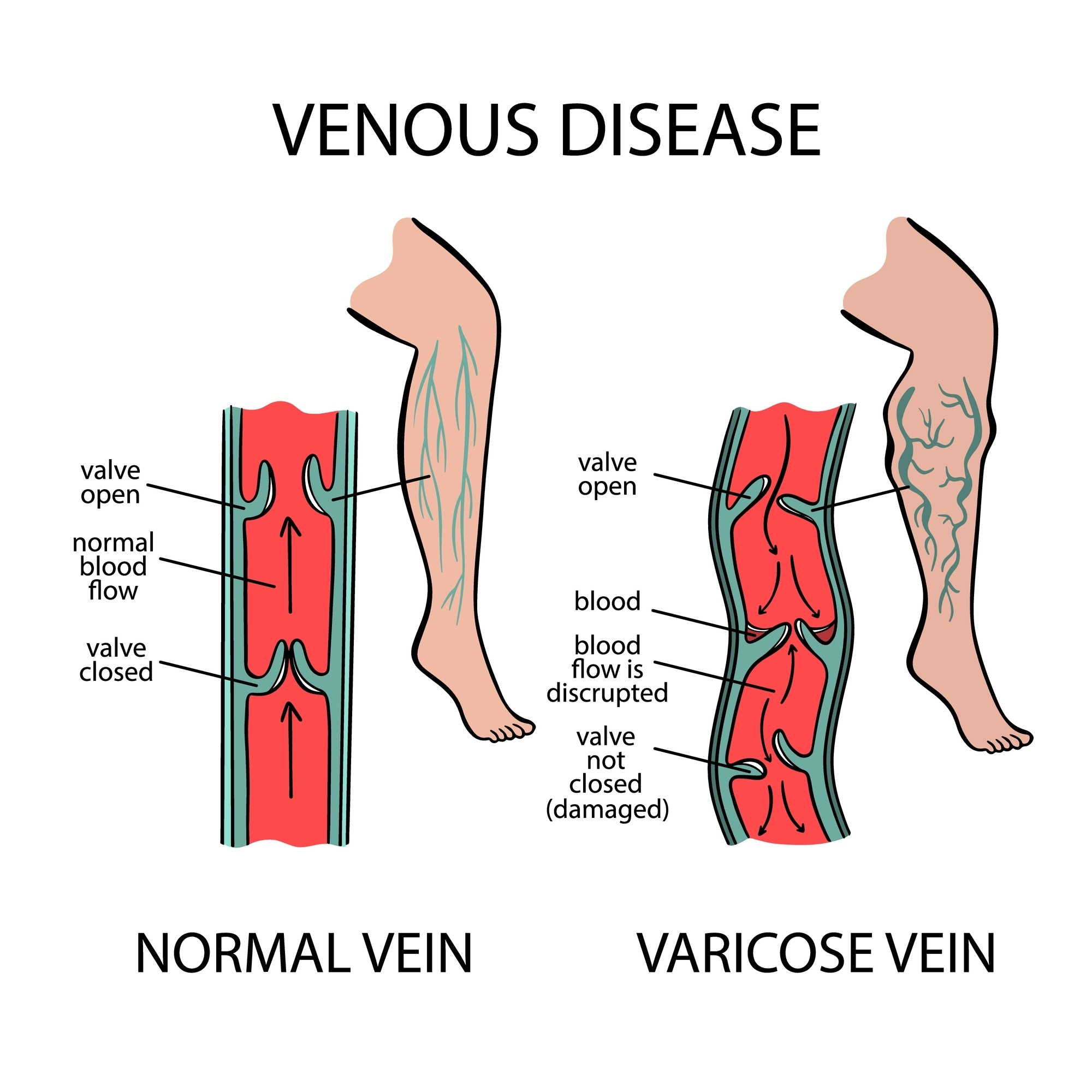
Who Is At Risk of Varicose Veins?
Risk factors for varicose veins include:
- Family history: If varicose veins run in your family, you are more likely to develop them[1].
- Obesity: Excess weight increases pressure on the veins, increasing your risk of varicose veins.
- Smoking: Tobacco use may damage the valves of your veins.
- Age: As we age, the valves in the veins weaken, leading to inefficient blood flow, which can cause blood to pool in the veins.
- Gender: Women are more prone to varicose veins due to hormones that relax vein walls. Hormonal changes during menstruation, pregnancy, or menopause, as well as hormone treatments like birth control pills, can contribute to the condition.
- Pregnancy: Increased blood volume during pregnancy supports the growing baby but can also enlarge the veins in the legs.
- Prolonged sitting or standing: Staying in one position for long periods impairs blood circulation, increasing the risk of varicose veins. Movement helps maintain proper blood flow.
How Are Varicose Veins Diagnosed?
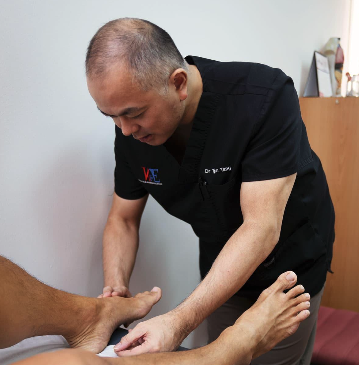
Varicose veins are typically diagnosed through a physical exam, but additional screening methods may be needed, such as:
- Doppler Ultrasound: This test uses sound waves to check blood flow and detect abnormalities.
- Duplex Ultrasound: A more detailed test to evaluate vein structure and blood flow.
It is noteworthy that you may not see any varicosities under the skin to prompt a check-up. Instead, you may experience symptoms like leg heaviness, night cramps, swelling, and skin changes.
This is because a hidden vein beneath the inside of the thigh and calf may be faulty, demonstrating venous reflux, a condition known as chronic venous insufficiency.
A Duplex ultrasound prior to intervention is essential to confirm the diagnosis, map the extent and severity of the varicose veins, assess the anatomy of the faulty vein, and guide which technique would be most suited to treat the underlying venous problem.
The ultrasound scan will also check the patency and valve function of the deep vein system to ensure there has been no previous deep vein thrombosis or blockage.
The examination takes about 30 minutes per leg. The procedures involved in the diagnosis are non-invasive and painless. Additionally, they may be covered by insurance if subsequent surgical procedures are required to treat your varicose veins.
What is the Treatment for Varicose Veins?
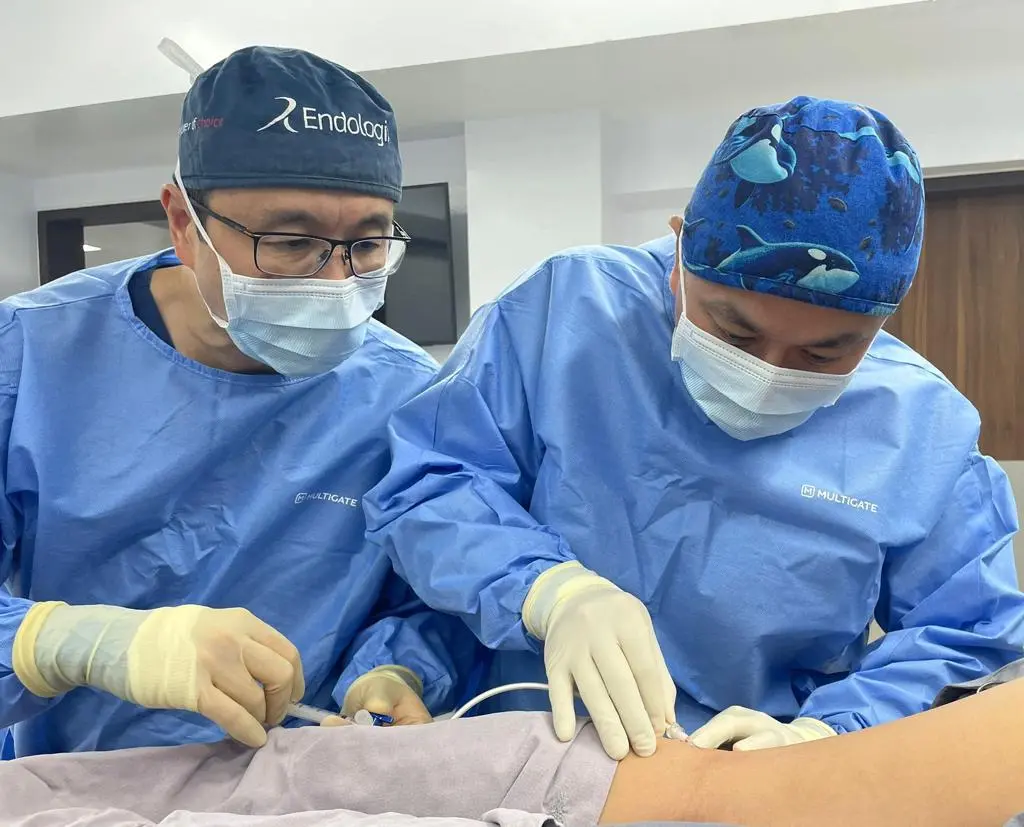
Varicose veins can be managed through various treatment options, categorized into surgical and non-surgical methods.
In most cases, non-surgical methods are enough to prevent the onset or delay the progression of the diseases; but for already-diseased veins, surgery may be necessary.
Surgical Treatment Options
These procedures aim to remove or close the affected veins:
- Endovenous Thermal Ablation (EVTA): A minimally invasive procedure that uses laser or radiofrequency energy, or microwave technology to heat and close off varicose veins, redirecting blood flow to healthier veins.
- Vein Stripping and Ligation: Involves tying off (ligation) and removing (stripping) the affected veins through small incisions in the skin. It is mainly used for veins larger than 2cm in diameter.
- Clarivein: Treats varicose veins by using a rotating catheter to irritate the vein walls and injecting a solution that causes the vein to collapse and seal off. This method is quick, effective, and typically involves less discomfort and downtime compared to traditional treatments.
- Venaseal: Uses a medical adhesive to close off varicose veins, allowing the body to reroute blood to healthier veins without the need for incisions.
- Microphlebectomy: Involves removing small varicose veins through tiny punctures in the skin, usually without the need for stitches.
Of the above-mentioned, EVTA and Venaseal typically have higher success rates.
Non-Surgical Treatment Options
- Foam Sclerotherapy: Involves injecting a foam solution into the varicose veins, causing them to collapse and eventually be absorbed by the body.
- Compression Stockings: Specially designed stockings that help improve blood flow in the legs by applying pressure to the veins, reducing symptoms and preventing the progression of varicose veins.
- Daflon Tablets: Helps improve the tone of the vein walls in the leg to push the blood back into circulation and ease leg heaviness, cramps and swelling. Daflon tablets contain high-dose flavonoids and are the only medication that helps with vein symptoms. The original tablets have the best efficacy compared to the generic ones.
At-Home Management Options (For the relief of symptoms)
- Exercise: Regular physical activity, such as walking or swimming, can improve circulation and strengthen leg muscles, reducing pressure on veins.
- Elevating the Legs: Raising the legs above heart level for periods throughout the day can help reduce swelling and improve blood flow.
- Weight Management: Maintaining a healthy weight can lessen the strain on veins and reduce the risk of developing varicose veins.
- Dietary Changes: Eating a diet rich in fibre and low in salt can prevent constipation and reduce swelling in the legs. Incorporating magnesium, vitamin C, and flavonoid-rich foods, such as berries, can also support overall vein health.
While at-home options can support overall vein health and serve as early preventive measures, they are best utilised in conjunction with professional treatments for optimal results in managing varicose veins.
TL;DR Varicose Veins Treatment Methods and Recovery Time
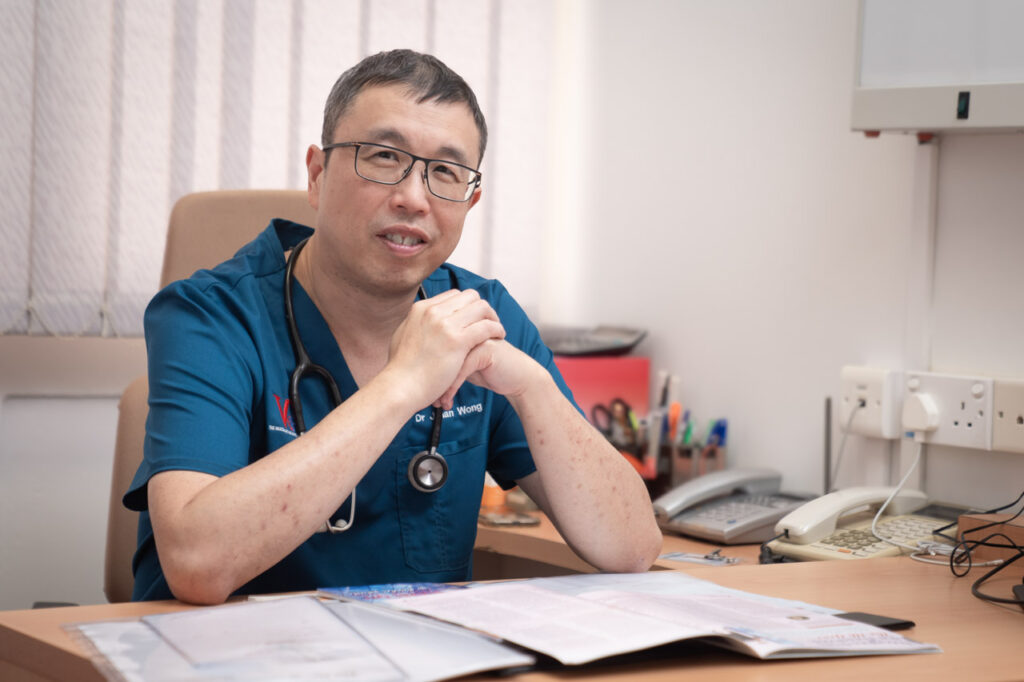
Treatment Type
Cost Range, Surgeon’s Professional Fees
(SGD)*
Endovenous Ablation using either laser/radiofrequency or microwave technology (One Leg)
Code: SD713V
Endovenous Ablation using either laser/radiofrequency or microwave technology (Both Legs)
Code: SD714V
Surgery
Code: SD808V
Sclerotherapy
Code: SD717V
*Please note that cost ranges are based on MOH’s benchmarks and not inclusive of GST and facility or equipment fees. Your final bill may also vary depending on the complexity of your case and treatment required. Separate fees for consultation and screening apply.
For detailed billing breakdowns, please contact our clinic for more information.
Consultation & Screening at The Vascular and Endovascular Clinic
Cost Range (SGD)
First Consultation
From $215
Follow-Up Consultation
From $132
Additional Clinic-Based Duplex Ultrasound
$110 – $220 (Depending on complexity)
Does Insurance Cover Varicose Vein Treatment in Singapore?
Yes, insurance can cover most of your treatment costs if you have an Integrated Shield Plan in Singapore. However, the coverage and claimable amount can vary based on your specific insurance policy and the type of treatment required for your condition.
It’s recommended that you contact our clinic and consult your insurance agent to clarify the exact coverage and claimable amount for your varicose vein treatment.
You can also utilise Medisave to help offset some of the costs of varicose vein treatments. The claimable amount varies depending on the specific procedure and the guidelines established by the Ministry of Health (MOH).
Varicose Vein Treatment at The Vascular & Endovascular Clinic

Our clinic offers a suite of varicose vein treatments tailored to your needs and condition. Where possible, we provide patients with severe symptoms consultation, screening, and treatment all within the same week.
Our team is also dedicated to offering financial counselling, assisting with insurance claims, and obtaining a Letter of Guarantee from your insurance provider.
For patients without private insurance, we welcome you to discuss your options with our clinic staff, as we strive to cater to your needs with a cost-effective treatment plan.
Why Choose The Vascular & Endovascular Clinic
At The Vascular & Endovascular Clinic, patients can expect the highest level of care from fellowship-trained vascular surgeons who specialize in minimally invasive and complex vascular surgeries.
We also work hand-in-hand with dedicated vascular sonographers, providing accurate diagnosis for optimal treatment.
With a commitment to treating all types of vascular and wound disorders, our clinic offers comprehensive and up-to-date solutions tailored to each patient’s needs. Our team’s compassionate approach ensures that every patient receives attentive care and ongoing support throughout their health journey.
If you have concerns regarding your vascular health, contact us to make an appointment with our doctors today.
References:
- https://journals.sagepub.com/doi/10.1177/1358863X14566224
- Liaudginas T , Kazlauskaitė V. Varicose veins surgical treatment: Endovenous laser ablation versus open surgery: PS118. Porto Biomed J. 2017;2(5):242. doi:10.1016/j.pbj.2017.07.154
- Tang TY , Yap CJQ, Chan SL, et al. 3-year clinical outcomes of A Singapore VenaSeal™ real world post-market evaluation Study (ASVS) for varicose vein ablation. CVIR Endovasc. 2024;7(1):41. Published 2024 Apr 27. doi:10.1186/s42155-024-00452-8
- https://www.radiologyinfo.org/en/info/Phlebectomy
Disclaimer: The information and content provided in this guide are for informational purposes only. They are not intended to replace professional medical consultation, diagnosis, or treatment, nor to endorse any particular treatment option.
